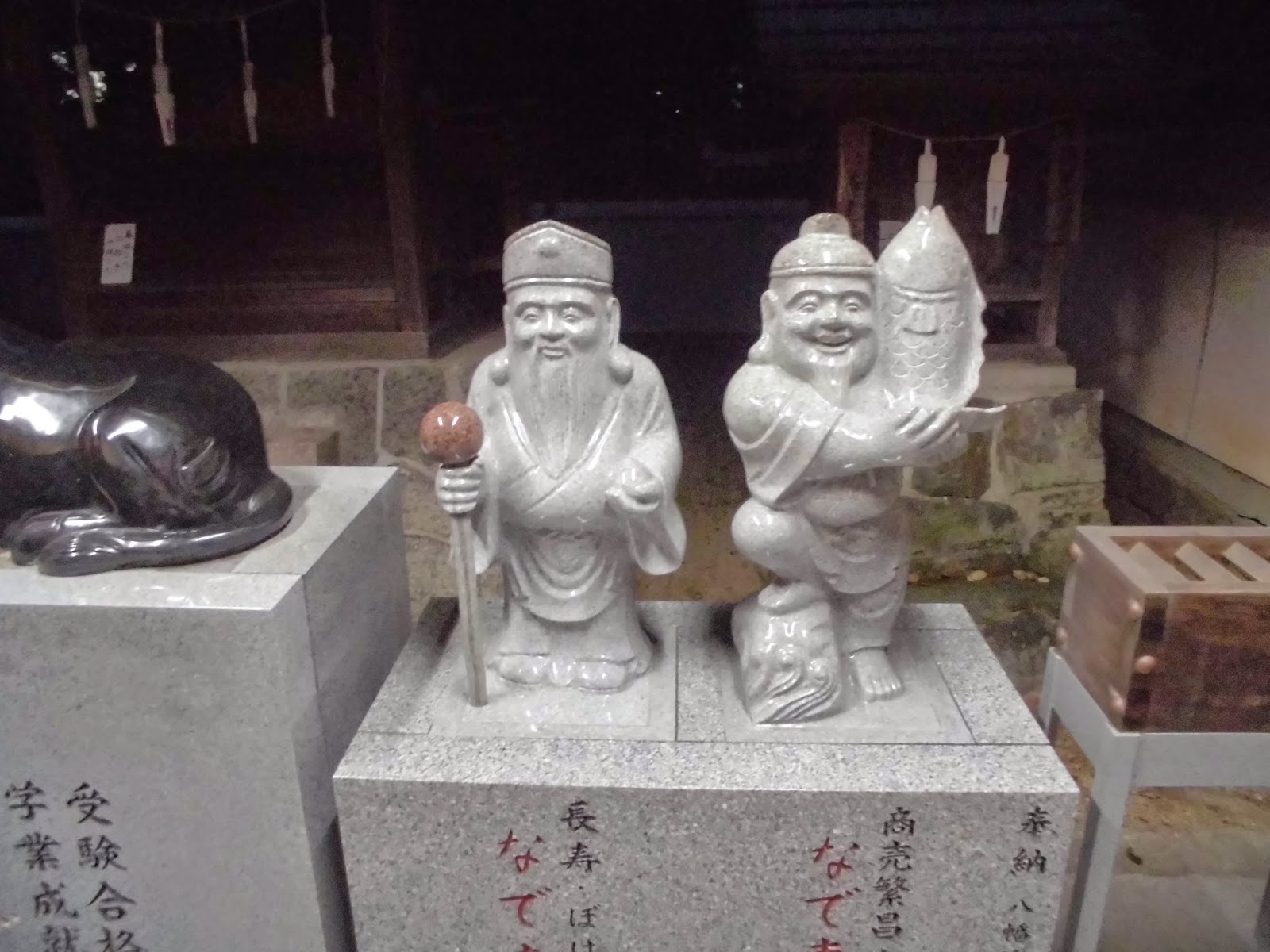Let's pick up where we left off. We've visited 2 temples, we still have 5 more to go.
伊予七福神の巡拝を続けよう!
在7裏面我看到這個茶,注意到是台灣的名牌。
The next temple, is Shofukuji, in which Hotei resides. It's right next to a cattle shed.布袋が祀られている昌福時。隣りに牛小屋があった。
下一座廟是昌福寺。有布袋的廟。旁邊是牛舍。
And there are some beautiful white magic lilies (higan flowers).
白い彼岸花も見かけた。
白色的石蒜
Here's Hotei. Hotei is a god of riches and good health. He is depicted as a fat, shirtless god, and he usually carries a large bag with him. (It's filled with treasure!) Hotei is a Buddhist god who is thought to have been a real person who lived in China a long time ago.
布袋さんは仏教の神だけど、中国に実在した人物だと言われている。
布袋本來是出自中國。
A spider and a Japanese Ojisan.
日本の蜘蛛とおじさん。
日本的蜘蛛和歐吉桑。
Here is a statue of Jizo. Aside from being a god who protects travelers, Jizo also protects children. People who lose young children or fetuses to death often come to temples like this that feature Jizo and ask him to protect their children in the afterlife.
子供を守る地蔵菩薩もここにある。
地藏不但是保護旅人的神,也保護早死的孩子。
Next to the temple was this torii. In back of the temple was a small shrine. Toriis like this denote the entrance to a sacred space, typically the grounds of a Shinto shrine.
お寺の裏に神社があった。
在(佛教)寺廟後面也有一座神社(神道)。
It's a very small shrine.
There's also a pretty pond with lotuses in it.
蓮の池もあった。
蓮花很漂亮。
秋だなぁ!
在攤曬的稻米。
It's time for the next visit. This time it's a shrine called Iyoinari Shrine. It houses Ebisu. The shrine is on top of a hill, and at the bottom of the hill is this torii. Ebisu is the only one of the seven gods who is originally from Japan. He is a god of fishermen, and is usually portrayed with a fishing rod and holding a big fish. He is also a god of merchants.
次に行ったのは伊豫稲荷神社だった。ここには恵比寿が祀られている。
下次我們去伊豫稻荷(ㄧ・ㄧㄡ・ㄧ・ㄋㄚ・ㄌㄧ)神社。是有惠比壽的。惠比壽是唯一出自日本的七福神。祂是捕魚的神佛。
Looking back down the hill.
丘の上にあったこの神社は景色がいい。
Now here's the entrance to the shrine itself.
因みに恵比寿は七福神の中に唯一日本出身の神だ。
Like all shrines and temples in Japan, there is a basin to wash ones hands at the entrance. I liked the frogs at the base.
可愛い蛙が手水舎を支えている。
日本的寺廟和神社都有洗手的設備在入口。這一個有青蛙在下面。
Because this is an "Inari" shrine, there are lots of statues of foxes. Inari is a god of good harvest and wealth, and his symbol is the fox. White foxes also serve as his messengers.
稲荷神社だからキツネがたくさんいた。
上面我寫「稻荷」(ㄧ・ㄋㄚ・ㄌㄧ)。這是一個神佛的名字。因為稻荷的象徵是狐狸,所以這樣的稻荷神社有很多狐狸。
I really liked these naughty looking foxes below. Foxes often appear as tricksters in Japanese folk tales. They are supposed to be able to change shape at will, so they often pose as people or objects in order to trick people.
人間に意地悪しそうなキツネ。
There were more buildings behind the main one.
A torii tunnel
Even the roof-corner decorations, which would usually be stylized dolphins or lions are foxes instead.
The view from this shrine straight down the hill towards the sea is really nice.
This is the last place we visited on this day. As you can tell, it was already getting dark. This is the Itsukushima Shrine. Juroujin is here. Juroujin is the other old man god aside from Fukurokuju. Unlike Fukurokuju, who has an elongated forehead, Juroujin mostly just looks like an ordinary old man with a hat. Like Fukurokuju, he is also a god of long life.
この日最後に行ったのは厳島神社。寿老人が祀られている。もうだいぶ暗くなったところなので、いい写真は撮れなかった。
這天最後一座是嚴島神社。有壽老人。跟福祿壽一樣,壽老人是長壽的神佛。我們到了這裡已經變很黑了。
It was already so dark it was hard for me to get many good photos. The atmosphere on this one is kind of neat though, even if it looks a little grainy.
Here's a statue of Juroujin (left) and Ebisu (right).
寿老人と恵比寿。寿老人は福禄寿と同じく、長寿の神。また、中国の道教出身。
左邊是壽老人。右邊是惠比壽。
There were also some cicada carapaces. Summer is over...
夏はもう終わりだ、、、
蟬子的甲殼。
That's it for this first day, but we've still got two more of the Seven Gods of Luck to visit, not to mention some more of Ehime's sights!
七福神は後二箇所!
還有兩個七福神。下次繼續!













































No comments:
Post a Comment